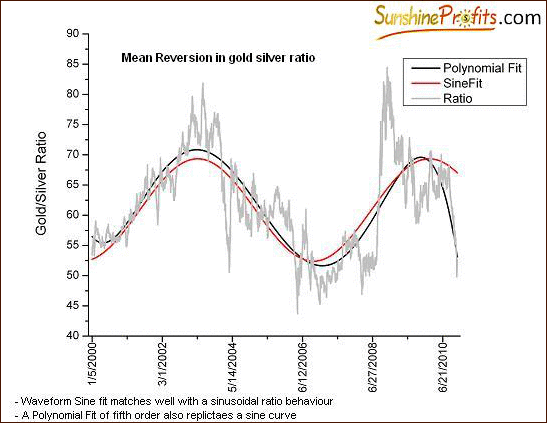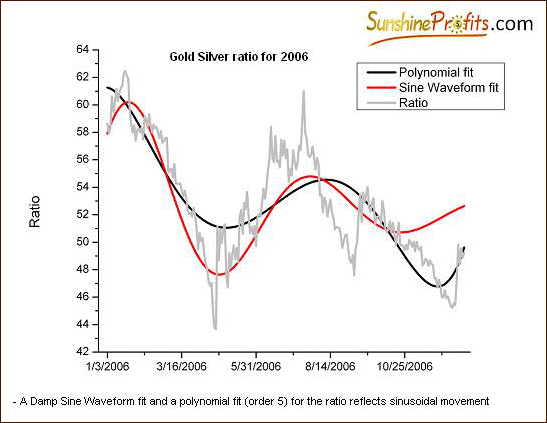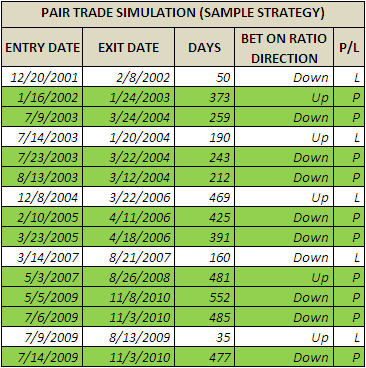Silver Outperforms Gold - Profit! Silver Underperform Gold - Profit Again!
Commodities / Gold and Silver 2010 Dec 21, 2010 - 01:29 PM GMTBy: Mike_Stall
 In our earlier essay, we saw how the silver-gold pair is ideal to bet on for mean reversion. We also saw how to make use of the mean reverting properties of any ratio. Continuing on that topic, we will investigate whether mean reversion holds true for the gold-silver ratio in particular. We will examine variables one should watch over when looking at regime changes (points where the mean is set to new values). We will also explore a simplistic trading strategy on the ratio based on some core parameters that determine entry and exit points.
In our earlier essay, we saw how the silver-gold pair is ideal to bet on for mean reversion. We also saw how to make use of the mean reverting properties of any ratio. Continuing on that topic, we will investigate whether mean reversion holds true for the gold-silver ratio in particular. We will examine variables one should watch over when looking at regime changes (points where the mean is set to new values). We will also explore a simplistic trading strategy on the ratio based on some core parameters that determine entry and exit points.
It must be noted that this essay is a simplistic approach to pair study. Real life strategies could be more complex. Also, mean reversion is not a winning proposition all the time. With proper stop losses, however, it will be observed that it works out well on the winning side over a number of trades. Where pair trading scores over normal trading is that positions are hedged and market exposure is lesser than single positions. Also, when one realigns portfolios (i.e. using pair trading signals to work in the long term), the question of losses is obsolete – the attempt is to increase returns of the precious metals portfolio and it has been observed that acting on information from the ratio will increase returns significantly (as compared to not acting on it at all).
Does the Gold-Silver Ratio Really Revert to Its Mean?
A long-term gold-silver ratio chart shows a wide range of 45 to 85. So do gold and silver really revert to their mean? Here the investor has to be aware of the notion of a moving average measure of the mean and use it rather than a fixed one. A Moving average serves the purpose of an average while taking recent history into account. That is, while a 10 year simple average may not be relevant today, a moving average lays emphasis on current market conditions and provides a more tradable average number. Also, the investor must be aware of the phenomenon of regime changes. Regime changes arise from fundamental changes in the components of the ratio (we will see various regimes in a separate study in our next article). However, a visual inspection of the ratio over the past ten years shows visible signs of a sinusoidal move. A long term moving average trendline emphasizes how the ratio oscillates between peaks and troughs.

The ratio, when broken down into smaller subsets of time, also shows the same character of mean reversion. This is somewhat analogous to fractal theory - a fractal is a “fragmented geometric shape that can be divided into parts, each of which is an approximate copy of the whole (self similarity)”. When we break the 10-year chart into smaller domains of a year (or even smaller intervals), we still observe mean reversion. We have provided a sample chart for the year 2006. The property of mean reversion is observed over any time domain – traders have to define their own frequency of trade and analyze the ratio accordingly.
Please take a look below to see how the mean reversion worked in a smaller time frame in 2006.

Clearly, two abovefeatured charts are very similar (fractal nature of the markets) and and the gold:silver ratio moves above and below its averages in both cases.
Can the situation change, so that betting on the ratio will not play out exactly as expected? Yes, however there is a way to deal with that.
Detecting Regime Changes
Detecting regime changes is critical to pair traders or even long term investors taking cues from the ratio. Regime changes are critical because it helps to reset any existing model (in terms of trading signals). Because the pair is analyzed on the basis of averages, it is imperative to know if any changes in fundamentals alter the average numbers.

One of the most important indicators highlighting a possible regime change is a relative high correlation combined with a wide divergence between a long-term and short-term moving average. A wide divergence shows that there has been a recent tendency of the ratio to move wide apart from the earlier averages. However, a high correlation implies that despite the changing ratio numbers, the relationship between gold and silver is still intact. This means that the current change in ratio numbers is likely to stay intact – a weakening relation evident from lower correlation could imply a likely reversion of the ratio.
Our graph uses a 6-month moving average as a long-term measure while a 10-day average is used as a short-term measure. This is not a thumb rule – indicators are chosen keeping the investment horizon in mind (and extensive backtesting for the quant-advanced Investors). We observe at least three points on the graph where the criteria of high correlation and high divergence are met. It is also perhaps interesting to note how the ratio falls into a new ‘steady state’ following such a regime change.
Regime changes are not only graphically or quantitatively detected. One should be on the lookout for fundamental reasons why the ratio should change. For example - setting a silver standard where silver would be used as money, while gold would not be used. In this hypothetical case the demand for silver would soar while the demand for gold would stay at the same level, and thus the gold:silver ratio would decline and most likely not reverse soon after that, as the factor that caused the ratio would not be purely emotional - it would be fundamental and sustainable.
Vital Parameters in the Pair Trade Game
Because a pair trade is based on the property of mean reversion, the most important parameter in a pair analysis is the average itself. A moving average is most commonly used because it retains more recent information than historic. Exponentially moving average (less popular than the simple moving average) measures can also be setup wherein old historic values continue to impact today’s average (with emphasis on older data decaying exponentially), while new data is also weighed in. The time period of the moving average taken will depend on the investment horizon or trading frequency aimed at. For long term investors a 1 year moving average (or an exponential one with more weight on historical data) would be used, while a short-term trader would possibly look at a 10-day average (or an exponential one with significantly more weight on recent data).
The other important parameter of interest in pair trading is the entry and exit signals. Generally, these points are where the moving average measure intersects the actual ratio (or a short term moving average that closely follows the actual ratio). Some traders enter when the actual ratio is a certain degree above the mean (i.e. wide divergence), and exit at the mean when it reverts. Some other traders favor entry at the mean and exit when it is diverged sufficiently from the mean again. This is subject to well-tested strategies and there is no single rule that wins.
Correlation has to be the third parameter we look at because the entire philosophy of mean reversion is based on the expectation that the pair reverts to means due to the high correlation between the two legs. We have said earlier that when the ratio changes away from the mean drastically without a drop in correlation, it signifies a strength in the new move (hence a new regime). Similarly, a low correlation when the ratio diverges well away from the mean is favorable for mean reversion. Therefore, divergence away from the mean is not the only indicator investors should be looking at, correlation is also to be monitored.
We add one more parameter of interest in pair trading – volatility. A higher volatility when the ratio moves away from the average is indicative of an unsteady movement and therefore a signal for the ratio to mean revert and vice versa. Generally, with a good choice of moving average/divergence/correlation, volatility is already accounted for. That is, a wide and sudden fluctuation alone leads to a good divergence (a gradual one will be reflected in the long-term moving average as well) – something that will inevitably lead to higher volatility. A weakening correlation is indicative of volatile moves in the prices of gold and silver. However, it is still a good practice to follow volatility moves of the ratio as well to consider entry and exit points for trades.
Like most trades entered while due to a defined trading system, we must also have good choices of stop losses (in case of unexpected moves) and gain realizations (exit) to have a robust pair trading system.
We tested a random strategy (in terms of entry exit points) keeping in mind the discussed parameters. Our strategy looked for any crossing of rolling correlation with the ratio (i.e. any point wherein the moving average crosses the ratio triggers a trade signal). Namely, there were 2 cases:
1. The ratio is above the moving average. It then crosses the moving average and moves below it. We enter at this point (based on the expectation that the momentum will continue before it mean reverts again) expecting the ratio to go down further. Therefore, we short gold and long silver.
2. The ratio is below the moving average. It then crosses the moving average and moves above it. We enter at this point (based on the expectation that the momentum will continue before it mean reverts again) expecting the ratio to go up further. Therefore, we long gold and short silver.
In short, if the ratio crosses its moving average to the upside (moving above it) then we buy gold and short silver.
Because we wanted to have a lower frequency trading horizon, we took a 1-year moving average measure. We also checked for volatility (1–year standard deviation of the ratio should be over 3) and correlation (one year moving correlation is less than 0.85). Profits for the trades would be taken at 25% while the stop loss is 10%.

We observed that out of the 15 trades, 10 trades ended in profits (i.e. a 10*25=250% profit overall compared to 5*10=50% losses). The average holding period was 390 calendar days, and the true average return of each trade was about 12% if the whole capital was re-invested each time. By "true return" we mean that one would have increased his/her capital approximately 5.5 times, which is the same outcome if one would increase his/her capital by 12% 15 times in a row (taking compounding into account).
Given that losses could be minimized and profits enhanced when using more sophisticated measures of volatility, correlation and moving averages (and also stop loss, profit realization), it is almost established that our stand on pair trading works (at least it did in the past ten years of historical data).
As emphasized in our earlier essay, Investors with a long-term fundamental take on the precious metals market should not be primarily interested in pair trades. However, they may still take signals from the ratio and adjust exposure to gold and silver according to expectations and maximize portfolio returns.
We strongly suggest Investors and Traders to set aside only a small portion of their capital for speculative positions – including pair trade. The biggest emphasis would be on building a long-term precious metals portfolio. However, please note that Investors can treat the entry and exit signals as indicators to realign their portfolio and improve returns even in the long run.
Stay tuned to know the current state of the ratio and a fundamental dissection of the state of affairs (and also historical) in our next essay. We will explore the historical fundamental changes that have dictated the gold:silver ratio in our next article. Based on current fundamentals, we will see how the current state of the ratio signals a possible landmark change in gold-silver dynamics in the coming years and how we can act on the changing regime. Join our free mailing list today and get 7 days of free access to our Premium Service (Premium Updates + unique Charts and Tools). Ensure you do not miss the next essay of the trilogy (this being a follow up of the first essay on gold:silver ratio) where we examine the ratio from a fundamental viewpoint.
Thank you for reading.
Mike Stall
Sunshine Profits Contributing Author
Sunshine Profits
Interested in increasing your profits in the PM sector? Want to know which stocks to buy? Would you like to improve your risk/reward ratio?
Sunshine Profits provides professional support for precious metals Investors and Traders.
Apart from weekly Premium Updates and quick Market Alerts, members of the Sunshine Profits’ Premium Service gain access to Charts, Tools and Key Principles sections. Click the following link to find out how many benefits this means to you. Naturally, you may browse the sample version and easily sing-up for a free trial to see if the Premium Service meets your expectations.
All essays, research and information found above represent analyses and opinions of Mr. Radomski and Sunshine Profits' associates only. As such, it may prove wrong and be a subject to change without notice. Opinions and analyses were based on data available to authors of respective essays at the time of writing. Although the information provided above is based on careful research and sources that are believed to be accurate, Mr. Radomski and his associates do not guarantee the accuracy or thoroughness of the data or information reported. The opinions published above belong to Mr. Radomski or respective associates and are neither an offer nor a recommendation to purchase or sell securities. Mr. Radomski is not a Registered Securities Advisor. Mr. Radomski does not recommend services, products, business or investment in any company mentioned in any of his essays or reports. Materials published above have been prepared for your private use and their sole purpose is to educate readers about various investments.
By reading Mr. Radomski's essays or reports you fully agree that he will not be held responsible or liable for any decisions you make regarding any information provided in these essays or reports. Investing, trading and speculation in any financial markets may involve high risk of loss. We strongly advise that you consult a certified investment advisor and we encourage you to do your own research before making any investment decision. Mr. Radomski, Sunshine Profits' employees and affiliates as well as members of their families may have a short or long position in any securities, including those mentioned in any of the reports or essays, and may make additional purchases and/or sales of those securities without notice.
© 2005-2022 http://www.MarketOracle.co.uk - The Market Oracle is a FREE Daily Financial Markets Analysis & Forecasting online publication.



